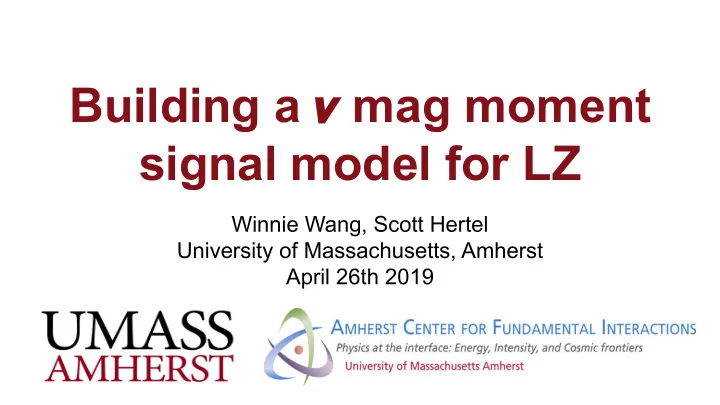

Building a 𝞷 mag moment signal model for LZ Winnie Wang, Scott Hertel University of Massachusetts, Amherst April 26th 2019
Noble Element Simulation Technique (NEST) A comprehensive simulation specifically focused on understanding how noble fluids produce signal quanta (i.e. scintillation and charge) This program pools data from multiple experiments to build response models, but allows for detector-specific inputs (efficiencies, field amplitudes, etc.)
Combining scintillation, charge to reconstruct energy spectrum W: Work function (recoil energy per signal quantum produced) S1: scintillation signal observed (unit in photons) S2: electron signal observed (unit in photons) g1: ‘S1 gain’, photons detected per photon produced g2: ‘S2 gain’, photons detected per electron produced Combining all variables give equation for reconstructed energy: LZ threshold set by S1: g1 (0.119) and a 3 PMT coincidence requirement
NMM Spectrum Data Specific to Xe atomic electron shells Provided by Jiuun-Wei Chen from National Taiwan University Noted by blue line: (Current best limit, from Borexino)
log(S2) vs. S1 Plot `True’ recoil spectrum is interpolated, then run through LZ-specific NEST. 1 million neutrino recoils simulated For each recoil, record expected S1, S2 values LZ Preliminary (In this plot, color scaling is arbitrary)
Reconstructed energy Following previous LZ sensitivity studies (arXiv:1802.06039): - Exposure assumed as 5.6tons x 1000days - Background is ~15 counts/keV/t/y (Rn-dominated) Reconstructed energy histogram: - Energy of electron recoils assumed from E_recon expression - Histogram constructed with 1keV wide bins - Rate is then normalized by exposure in detector Vertical error bars: simple Sqrt(n), where n=number of samples per bin
Reconstructed energy plot Takeaways: LZ Preliminary 1) Effective threshold is ~1keV Blue: True recoil Energy spectrum 2) LZ expects world-leading solar-neutrino magnetic moment sensitivity Red: simulated observation Next steps: 1) Practice making statistical Background : ~15 counts/keV/t/y statements using profile likelihood ratios 2) Repeat for other non-standard interactions
Recommend
More recommend